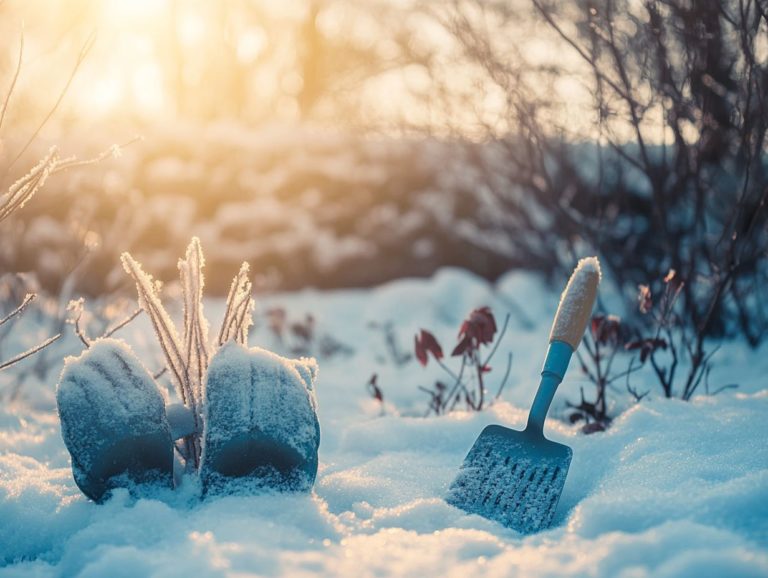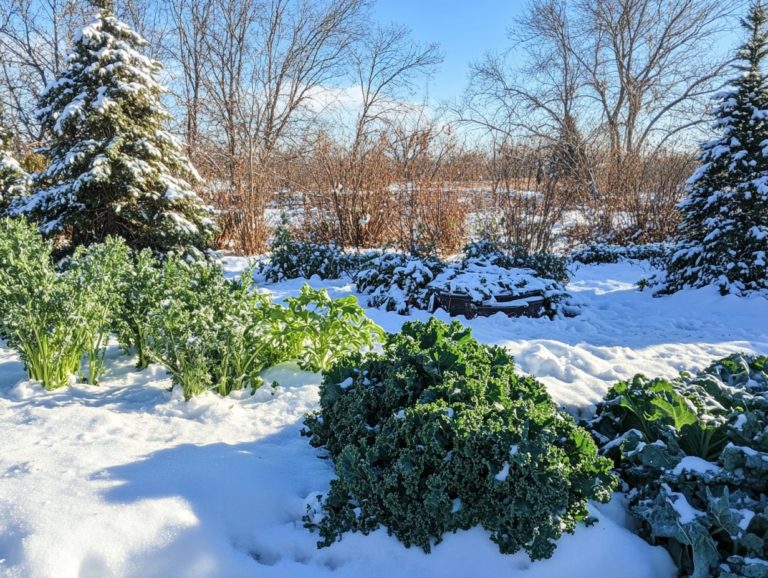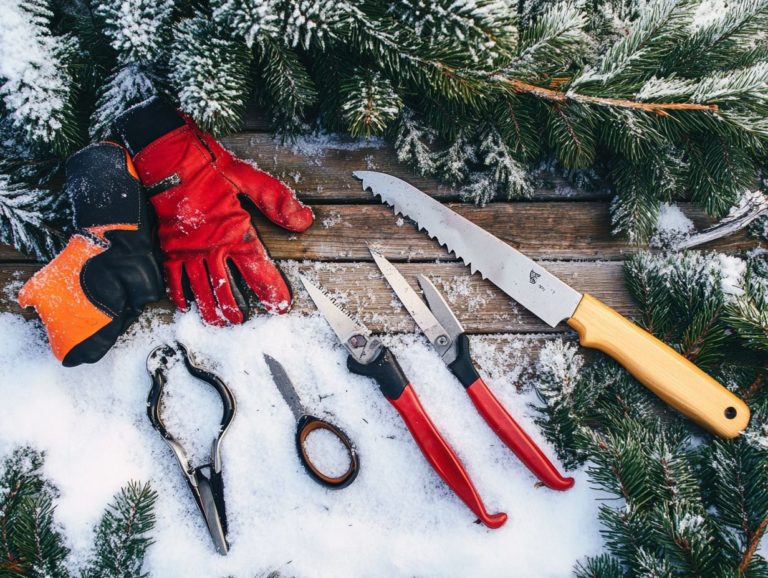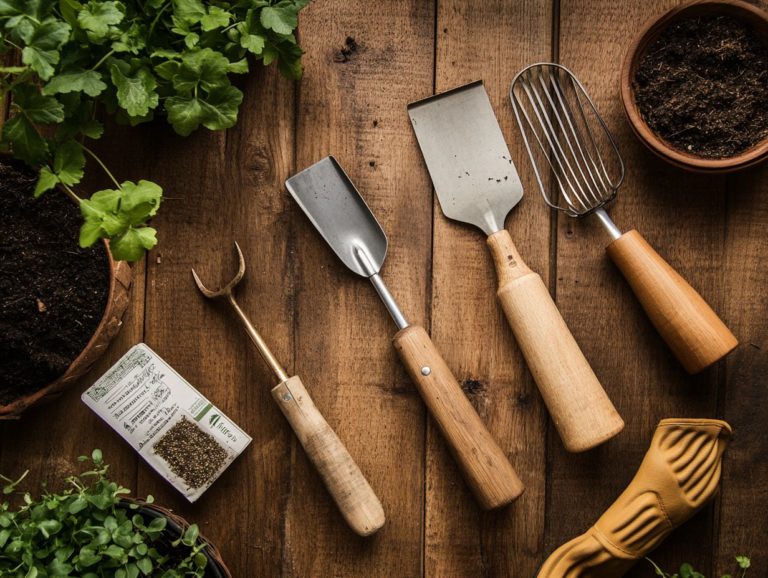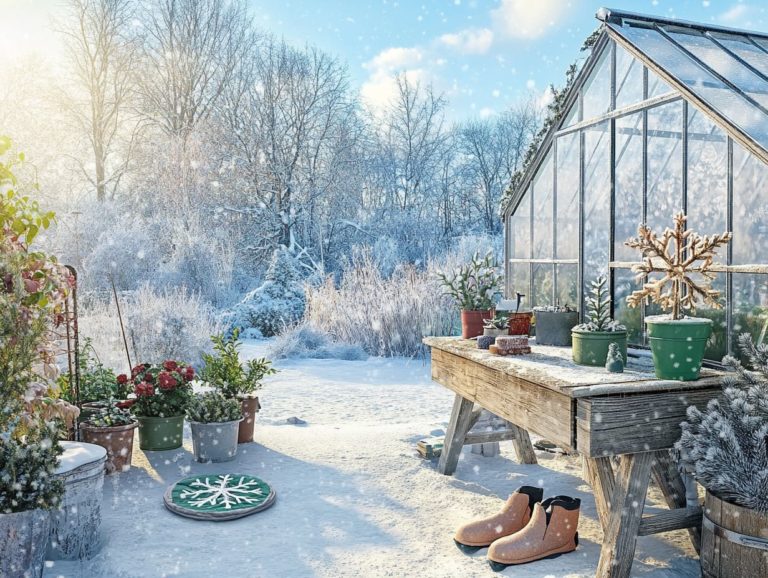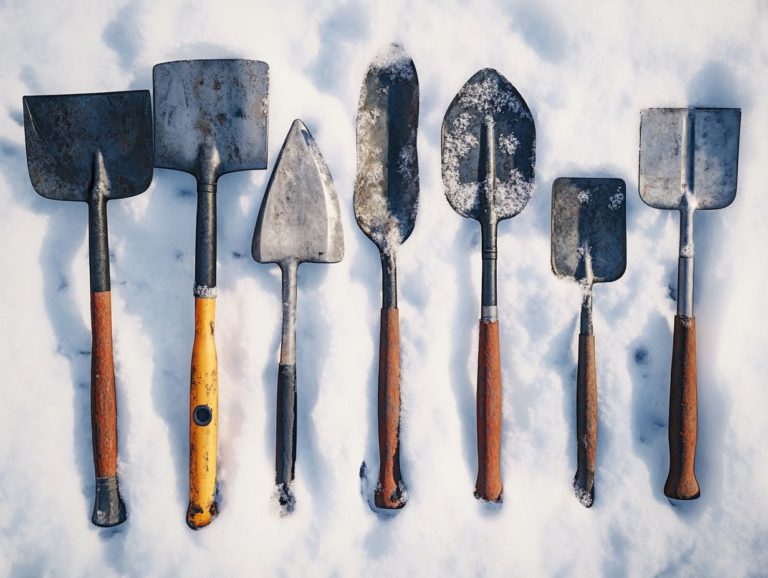Best Sowing Tools for Cold-Climate Gardens
Get excited about your gardening journey with these essential tools! Gardening in cold climates can be quite the undertaking, but equipped with the right tools, you can create a flourishing garden even when the temperatures dip.
This article discusses the essential sowing tools that every gardener should have, ranging from indispensable hand trowels to specialized seed dispensers designed for optimal performance.
Whether you’re an experienced gardener or just starting out, these tools will empower you to plant with confidence and nurture your garden into a vibrant oasis.
Explore the essential gear that will elevate your sowing success! Create an efficient workspace that enhances your organization while you garden.
Contents
- Key Takeaways:
- 1. Hand Trowel
- 2. Garden Hoe
- 3. Rake
- 4. Soil Knife
- 5. Garden Fork
- 6. Dibber
- 7. Seedling Tray
- 8. Seed Dispenser
- 9. Garden Gloves
- 10. Watering Can
- 11. Garden Scissors
- 12. Garden Kneeler
- 13. Plant Labels
- 14. Garden Cart
- 15. Garden Sprayer
- Frequently Asked Questions
- What are the best sowing tools for cold-climate gardens?
- Why is it important to choose the right sowing tools for cold-climate gardens?
- Can I use any regular sowing tools for a cold-climate garden?
- The Importance of a Seed Starting Tray in Cold-Climate Gardening
- Do I Need a Seedling Heat Mat?
- How Grow Lights Can Enhance Your Garden
Key Takeaways:
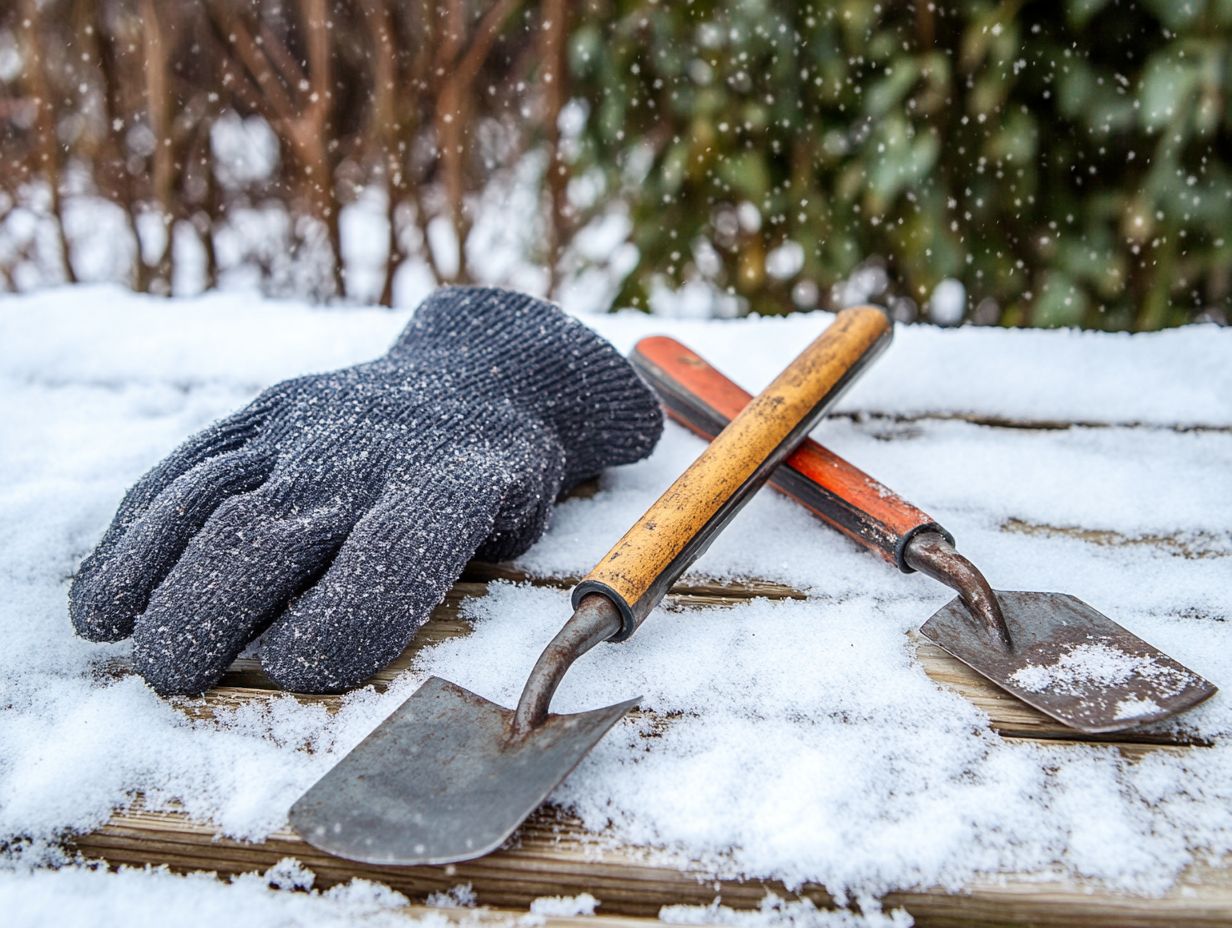
- Use a garden hoe to easily break up and aerate compacted soil, creating ideal conditions for sowing seeds.
- A soil knife is perfect for digging holes, cutting through tough roots, and weeding.
- Invest in a seed dispenser for precise sowing, preventing overcrowding and ensuring proper spacing for healthy growth.
1. Hand Trowel
A hand trowel is a critical gardening tool that gives you the precision needed for tasks like planting, transplanting, and digging in tight spots. It helps keep the soil around delicate plants undisturbed. This versatile tool is particularly invaluable in smaller gardens or urban landscaping projects, where every inch counts in creating stunning blooms and thriving greenery.
When selecting a trowel, you’ll find various options, including pointed, round, and wide-blade styles. Pointed trowels excel at breaking up hard soil or creating small holes for seedlings, while round trowels are great for lifting and turning soil in containers. If comfort is a priority, especially during extended use, consider ergonomic designs that cater to larger hands. These tools are perfect for pruning and maintaining your garden.
Don’t overlook the material; stainless steel trowels resist rust and wear, making them a durable choice, while lightweight plastic options may be better for occasional use. Along with hand trowels, tools like soil knives and cultivators can enhance your gardening experience.
Regular cleaning and proper storage will extend your tools’ lifespan, ensuring they remain sharp and effective whenever you get your hands dirty.
2. Garden Hoe
A garden hoe is an essential companion for any gardener. It is primarily used for weeding and working the soil, making it easier to maintain a healthy garden space throughout the growing season.
There are various hoes available, each crafted for specific tasks that enhance your garden maintenance. For example, the traditional long-handled hoe excels at deep tilling, while the Dutch hoe, with its cleverly angled blade, is ideal for slicing through weeds just beneath the soil’s surface.
Using these tools helps keep unwanted growth in check and improves soil aeration, reducing compaction and promoting optimal root development. To ensure your hoe lasts, remember to clean it after each use, store it in a dry place, and periodically sharpen the blades for effective cutting.
3. Rake
A rake is an essential tool for gardeners, playing a crucial role in gathering leaves, leveling soil, and preparing garden beds. It s key for maintaining a beautiful and organized gardening space throughout the seasons.
You’ll find various types of rakes, each tailored for specific tasks. For instance, a sturdy garden rake breaks up compacted soil, while a lightweight leaf rake excels at collecting fallen foliage. These tools elevate the visual charm of your garden and significantly contribute to the health of your plants by ensuring proper soil aeration and effective debris removal.
Regular raking, especially during the fall and spring, is vital for seasonal upkeep. It promotes optimal soil preparation, keeps pesky weeds at bay, and encourages healthy growth as your landscape transitions through the cycles of the year.
4. Soil Knife
The soil knife stands out as an innovative gardening tool. It has a razor-sharp blade that effortlessly slices through tough soil, making it ideal for weeding and transplanting. It s a must-have for every gardener!
Its unique design features a pointed tip and a robust steel blade. This helps you dig, slice, aerate, and loosen compacted soil with remarkable ease. This versatility means you can streamline your toolkit, saving both time and effort in your gardening endeavors.
When wielding the soil knife, your technique matters significantly. Employing a gentle rocking motion enhances its efficiency, especially when confronting stubborn weeds or dense root systems. Cleaning and oiling your soil knife prevents rust and preserves its sharpness, allowing it to perform effectively season after season.
5. Garden Fork
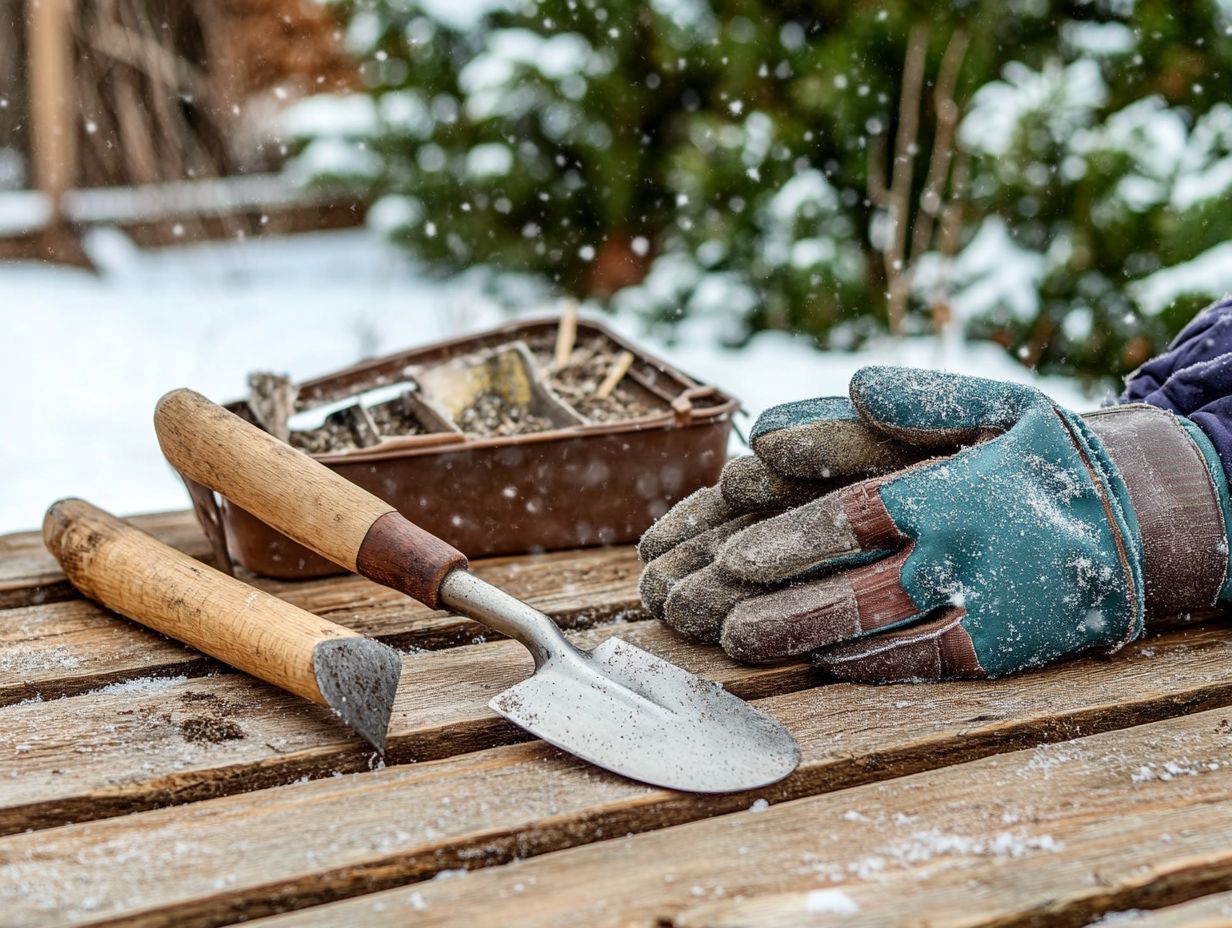
A garden fork is an essential tool in your gardening toolkit. It is specifically crafted to aerate soil, break up compacted earth, and assist with weeding. These elements significantly boost the health and productivity of your plants in any garden setting.
This multifunctional implement becomes invaluable during soil preparation for seeding. It allows you to incorporate organic matter and create a fine seedbed. It plays a crucial role in enhancing drainage, especially in heavy clay soils that might otherwise retain too much moisture and stifle plant growth.
Choosing the right garden fork is vital. Whether you opt for a broad-tined model for loosening garden beds or a narrow-tined version for precision work, different soil types require tailored tools to achieve optimal results. The right garden fork not only prepares the ground but also lays the foundation for a flourishing garden.
6. Dibber
A dibber is a simple yet remarkably effective gardening tool. It enables you to create precise holes for planting seeds and seedlings. This ensures optimal seed spacing and depth, laying the groundwork for successful germination and robust growth.
Utilizing a dibber elevates the organization of your garden and transforms the planting process into a more efficient and enjoyable experience. You can effortlessly glide from one spot to another, crafting uniform holes that foster healthy plant development.
In sandy or loose soils, a tapering dibber allows easy penetration, while in clay or compacted soils, a sturdier, wider design enables you to create varying depths without harming surrounding roots. To maximize its benefits, employ a consistent spacing template be it a string line or markers. This ensures you take full advantage of your dibber s precision.
7. Seedling Tray
A seedling tray is an critical ally for any gardener looking to cultivate plants from seeds. It offers a well-organized space for germination and growth before they transition into your larger garden landscape.
These trays come in various materials plastic, biodegradable options, and even reusable aluminum. Each presents unique advantages tailored to your specific gardening aspirations. Biodegradable trays are fantastic if you re keen on reducing your ecological footprint, as they decompose and enrich the soil once transplanted. They are especially useful during the colder months.
Proper care during the germination phase is crucial. Seedlings thrive on consistent moisture, appropriate light levels, and gentle temperature control to ensure robust growth. By following a well-thought-out watering schedule and ensuring proper drainage, you can significantly enhance your success. Don t wait! Get your seedling tray now and watch your garden flourish!
8. Seed Dispenser
A seed dispenser is a gardener’s best friend! It allows for precise and organized planting of seeds. This tool ensures uniform spacing and depth, promoting healthy growth and maximizing your available gardening space.
Seed dispensers come in various designs, from simple handheld models to sophisticated options that accommodate different seed types and sizes. Understanding the different styles can greatly improve usability and planting efficiency.
When selecting seeds, consider factors like soil conditions and climate, along with your garden’s intended layout. Utilizing a seed dispenser effectively can streamline your planting process. It makes arranging seeds in rows, grids, or intricate designs much easier.
This keeps optimal seed placement in check, leading to a vibrant and flourishing garden that you can be proud of. To get started, explore the essential tools for winter garden prep and choose your seed dispenser today to transform your garden!
9. Garden Gloves
Garden gloves are an essential component of your gardening toolkit, protecting your hands during various tasks like weeding, pruning, planting, and watering. They ensure comfort and safety throughout the gardening process.
Choosing the right gloves can significantly impact your gardening efficiency. You have a variety of options, including gloves designed specifically for winter tasks.
- Lightweight gloves for delicate tasks
- Heavy-duty varieties for tackling challenging jobs, like dealing with thorny plants
- Breathable models that keep your hands cool on hot days
Investing in the right pair shields you from abrasions and cuts and prevents blisters. This allows for longer, more productive gardening sessions as you prepare for winterizing your garden.
To keep your gloves in pristine condition, clean them regularly per the manufacturer’s instructions. Store them in a dry place to avoid deterioration. This ensures they remain a vital part of your gardening experience for years to come, especially when incorporating a checklist for winterizing your tools.
10. Watering Can
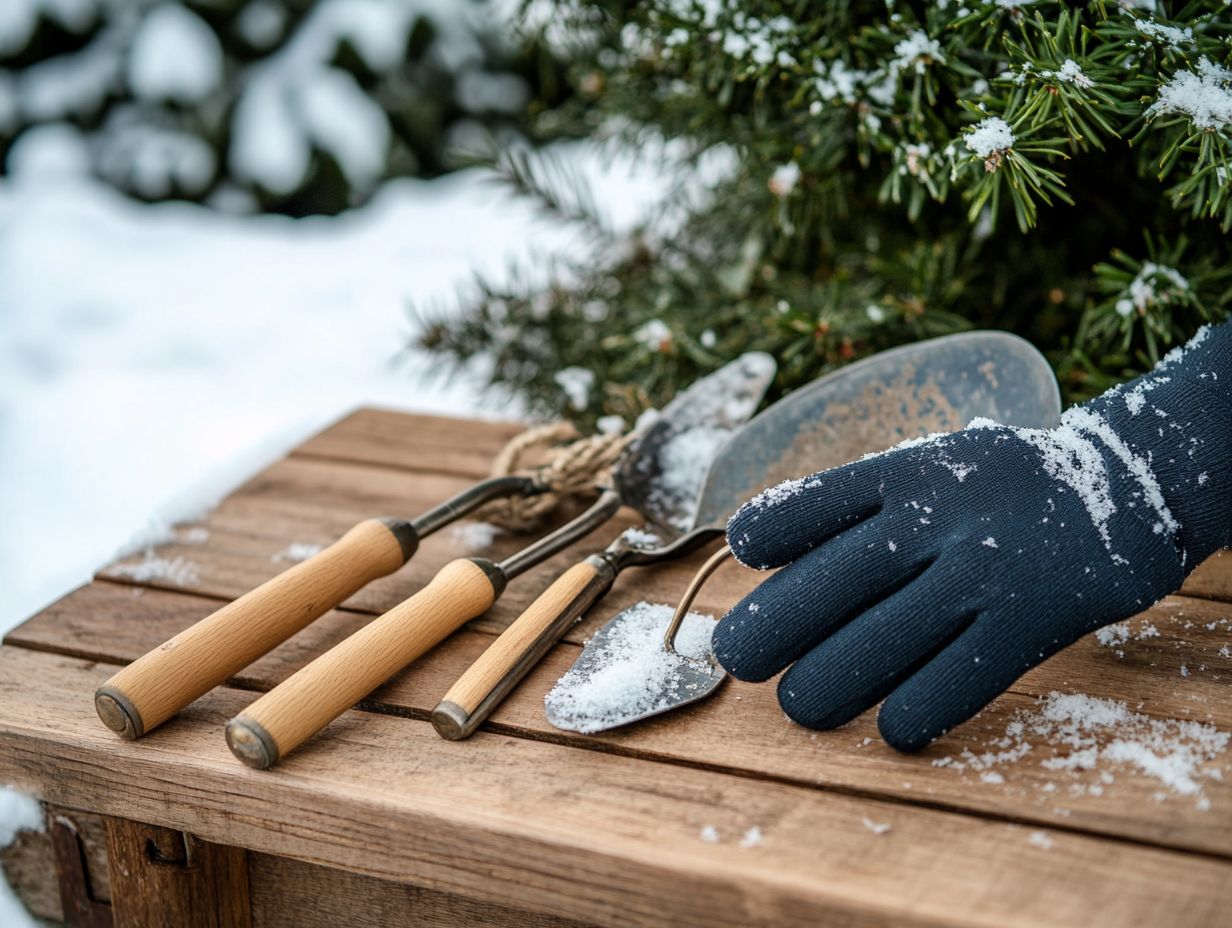
A watering can is an essential companion for any gardener. It offers a convenient and controlled method of providing vital hydration to your plants and flowers, helping them flourish throughout the growing seasons.
There s a diverse array of watering cans to meet your specific gardening needs. For instance, a traditional metal can combines durability with timeless elegance. Lightweight plastic options are ideal for less demanding tasks, like watering decorative plants.
If you re nurturing delicate seedlings or winter heather, opt for a can equipped with a fine spout, which is a narrow spout that allows for gentle watering without disturbing the soil.
Timing your watering is crucial for your garden’s health don t miss the early morning or evening slots! These times are often optimal as the sun s lower angle reduces evaporation, maintaining the perfect moisture level for your winter garden.
Employing a watering technique that encourages deep root growth ensures your plants develop resilience, resulting in a lush garden brimming with vibrant blooms, even as temperatures drop.
11. Garden Scissors
Garden scissors are critical tools for you as a gardener. They are expertly crafted for precise trimming and pruning of both ornamental grasses and edible gardens.
This attention to detail enhances the overall appearance of your garden and boosts its productivity, especially during the harvesting season.
With a diverse range of options available, including bypass pruners, anvil pruners, and telescopic pruning shears, each tool is designed with a specific purpose in mind. For example, bypass pruners are scissors designed to cut live stems cleanly, while extendable hedge shears shine when it comes to slicing through tougher branches.
When you’re selecting the perfect pair, take into account factors such as blade material, grip comfort, and your specific gardening needs. This way, you ensure that the scissors fit snugly in your hand and facilitate effortless use.
Choosing the right scissors makes your gardening tasks feel far less laborious, especially when tackling winter gardening tasks.
12. Garden Kneeler
A garden kneeler is an exceptional addition to your gardening toolkit. It offers the comfort and support you need for various tasks, particularly during the winter months.
This tool enables you to spend more time tending to your plants and maintaining a stunning garden, including decorative elements like a fire pit, without putting undue strain on your knees.
These versatile tools come in a range of styles, including foldable models for easy storage and options with side handles. These features also support tasks like arranging decorations for a winter wonderland.
Many designs feature padded surfaces that cushion against hard ground. This ensures ergonomic use that minimizes discomfort and reduces the risk of injury, especially when planting flowers or vegetables.
For passionate gardeners, tackling tasks like weeding, planting, or harvesting becomes a breeze. You can enjoy every moment in your garden!
The right kneeler not only supports your body but also fosters a deeper connection with nature. It transforms routine gardening into a comfortable and enjoyable endeavor, especially when surrounded by blooming flowers.
13. Plant Labels
Plant labels are a critical asset for you as a gardener. They streamline the organization and identification of various species within your garden.
These labels help you organize your winter plants and ensure that each one receives the tailored care it needs to thrive in all its glory.
These labels are available in a range of materials whether plastic, wood, or metal. Each offers distinct advantages suited to your gardening environment, including decorative options.
For example, waterproof labels are perfect for withstanding the elements without fading. You can even use them creatively to mark your decorative stones.
By employing a clearly labeled system, you can efficiently monitor growth patterns and record specific needs for light, water, and nutrients unique to each plant type. This is particularly important for winterizing your garden.
Introducing a color-coding system can elevate your visual organization. It allows you to easily identify which plants are ready for harvesting and which are just starting to bloom.
14. Garden Cart
A garden cart is an essential tool for gardeners. It provides an efficient means to transport tools, plants, and materials across the landscape, especially during the harvest season. It ensures organization and ease while you work, allowing for a smooth workflow with various gardening tools.
This handy tool reduces strain on your body and speeds up gardening tasks. Whether you’re moving heavy bags of soil, trays of seedlings, or basic tools, having the right cart can truly transform your operation. This ensures a more enjoyable experience, even when preparing for winter.
You’ll find different types of garden carts, from traditional flatbed designs to specialized wheelbarrow-style carts. Each type is suited for unique gardening tasks and comes with distinct advantages. Consider factors like load capacity and maneuverability, particularly when dealing with structures like water features.
When selecting the ideal cart, keep in mind factors like size, terrain compatibility, and durability. This will help make sure it fits your tools and can handle any critters you find. These considerations can greatly enhance your gardening experience, allowing for more efficient and enjoyable work, especially when entertaining guests around a fire pit or BBQ.
15. Garden Sprayer
Ready to take your gardening to the next level? A garden sprayer is a critical tool for any gardener, expertly designed to make it easier to water plants, apply fertilizers, and manage pests. This ensures a thriving environment for all your vegetation. Having this tool makes gardening easier, allowing you to enjoy the ambiance of your outdoor space.
Various types of garden sprayers are tailored to meet your specific needs. Handheld sprayers are perfect for smaller tasks, while backpack sprayers are ideal for tackling larger areas, especially when caring for ornamental plants. For expansive gardens, motorized options significantly enhance efficiency, making it easier to manage your winter layout.
Each sprayer serves its unique purpose. A handheld sprayer excels at delivering targeted treatments for delicate flowers like winter heather, while a backpack sprayer offers extensive coverage without undue strain. To maximize your garden s health, effective usage is essential, especially in preparation for the colder months.
Follow these essential tips to boost your garden’s health:
- Mix solutions precisely according to the labels, especially when preparing for winter.
- Check for even coverage to avoid missed spots, ensuring all your plants receive the right amount of care.
- Regularly clean the sprayer to prevent contamination, particularly after applying treatments for critters.
Timing matters when using a garden sprayer. Spray early in the morning or late in the evening to minimize plant stress and optimize absorption. This ensures your garden thrives beautifully throughout the winter months.
Frequently Asked Questions
What are the best sowing tools for cold-climate gardens?
Some of the best sowing tools for cold-climate gardens include a seed starting tray, seedling heat mat, grow lights, and a watering can with a narrow spout. To learn more about essential tools for cold-climate gardening, check out this guide on what tools are essential for cold-climate gardening, especially when considering their arrangement.
Why is it important to choose the right sowing tools for cold-climate gardens?
Cold-climate gardens require special attention and care. Using the essential gardening tools for cold climates can help ensure successful growth and a healthy garden, which is essential for a vibrant winter landscape.
Can I use any regular sowing tools for a cold-climate garden?
No, regular sowing tools may not be suitable for cold-climate gardens. They may not provide the necessary warmth and protection for seeds and seedlings, especially during the winterizing process. Instead, consider using the best tools for cold-weather herb gardens to ensure successful growth.
The Importance of a Seed Starting Tray in Cold-Climate Gardening
A seed starting tray creates a warm, moist spot for seeds to sprout. This is important in cold-climate gardens where low temperatures can hinder seed growth.
Do I Need a Seedling Heat Mat?
A seedling heat mat is a great addition to cold-climate gardens. It keeps the soil warm and ensures seedlings grow steadily, especially when working on your winter layout. For more information, check out the ultimate guide to cold weather gardening tools.
How Grow Lights Can Enhance Your Garden
Grow lights are vital for seedlings in cold climates. They provide essential light during winter months when natural sunlight is scarce.
Ready to start your winter gardening journey? Equip yourself with these essential tools!

